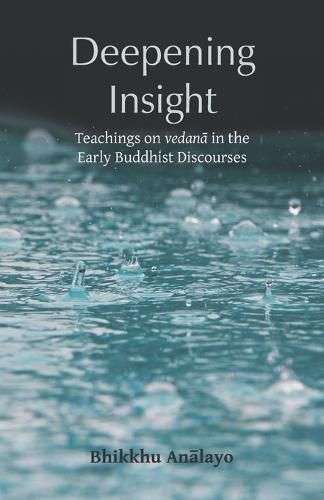Readings Newsletter
Become a Readings Member to make your shopping experience even easier.
Sign in or sign up for free!
You’re not far away from qualifying for FREE standard shipping within Australia
You’ve qualified for FREE standard shipping within Australia
The cart is loading…






The ensuing pages present a selection of passages from the early Buddhist discourses that provide perspectives on the cultivation of liberating insight into vedana, sensation,
feeling, or feeling tone. For meditators, such passages can be of considerable help as a reference point for deepening insight.
A metaphor that can offer considerable help when facing vedanas describes bubbles arising on the surface of a pond during rain…they arise and soon enough burst and disappear. Contemplation of the changing nature of vedana provides a firm foundation for the growth of insight into not self. Such insight proceeds through successive layers of the mind’s ingrained habit of self-referentiality. Based on relinquishing the explicit view of affirming the existence of a permanent self, increasingly subtler traces of conceit and possessiveness need to be successively overcome until with full awakening all selfing in any form will be removed for good.
Deepening Insight is based on textual sources that reflect early Buddhism, which stands for the development of thought and practices during roughly the first two centuries in the history of Buddhism, from about the fifth to the third century BCE. These sources are the Pali discourses and their parallels, mostly extant in Chinese translation, which go back to instructions and teachings given orally by the Buddha and his disciples. In those times in India, writing was not employed for such purposes, and for centuries these teachings were transmitted orally. The final results of such oral transmission are available to us nowadays in the form of written texts. Bhikkhu Analayo’s presentation is meant to provide direct access, through the medium of translation, to the Chinese Agama parallels to relevant Pali discourses. In commenting on such passages, his chief concern throughout is to bring out practical aspects that are relevant to actual insight meditation.
EndorsementsIn spring 1990 S.N. Goenka initiated an international seminar named The Importance of Vedana and Sampajanna. It had the purpose to disseminate the prominence of sensations (vedana) as a core object of meditation to recognize the intrinsic nature of change and impermanence.
Venerable Bhikkhu Analayo now provides a thorough, comprehensive and well selected collection on vedana as maintained in the original early Pali Canon. Along with the comparison to the Chinese Agama, otherwise hardly available, this collection if adapted and applied to practice may indeed serve as an inspiring source for deepening insight.
-Klaus Nothnagel, Pali teacher and Center Teacher for Dhamma Pallava in Poland
$9.00 standard shipping within Australia
FREE standard shipping within Australia for orders over $100.00
Express & International shipping calculated at checkout
The ensuing pages present a selection of passages from the early Buddhist discourses that provide perspectives on the cultivation of liberating insight into vedana, sensation,
feeling, or feeling tone. For meditators, such passages can be of considerable help as a reference point for deepening insight.
A metaphor that can offer considerable help when facing vedanas describes bubbles arising on the surface of a pond during rain…they arise and soon enough burst and disappear. Contemplation of the changing nature of vedana provides a firm foundation for the growth of insight into not self. Such insight proceeds through successive layers of the mind’s ingrained habit of self-referentiality. Based on relinquishing the explicit view of affirming the existence of a permanent self, increasingly subtler traces of conceit and possessiveness need to be successively overcome until with full awakening all selfing in any form will be removed for good.
Deepening Insight is based on textual sources that reflect early Buddhism, which stands for the development of thought and practices during roughly the first two centuries in the history of Buddhism, from about the fifth to the third century BCE. These sources are the Pali discourses and their parallels, mostly extant in Chinese translation, which go back to instructions and teachings given orally by the Buddha and his disciples. In those times in India, writing was not employed for such purposes, and for centuries these teachings were transmitted orally. The final results of such oral transmission are available to us nowadays in the form of written texts. Bhikkhu Analayo’s presentation is meant to provide direct access, through the medium of translation, to the Chinese Agama parallels to relevant Pali discourses. In commenting on such passages, his chief concern throughout is to bring out practical aspects that are relevant to actual insight meditation.
EndorsementsIn spring 1990 S.N. Goenka initiated an international seminar named The Importance of Vedana and Sampajanna. It had the purpose to disseminate the prominence of sensations (vedana) as a core object of meditation to recognize the intrinsic nature of change and impermanence.
Venerable Bhikkhu Analayo now provides a thorough, comprehensive and well selected collection on vedana as maintained in the original early Pali Canon. Along with the comparison to the Chinese Agama, otherwise hardly available, this collection if adapted and applied to practice may indeed serve as an inspiring source for deepening insight.
-Klaus Nothnagel, Pali teacher and Center Teacher for Dhamma Pallava in Poland